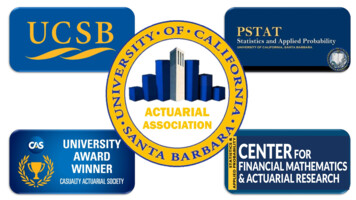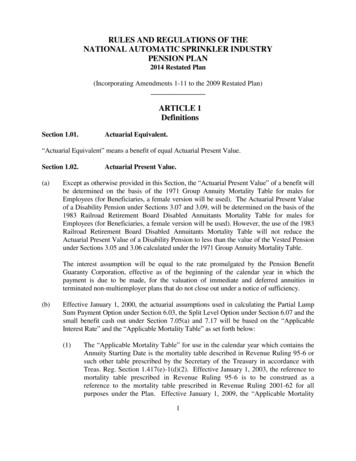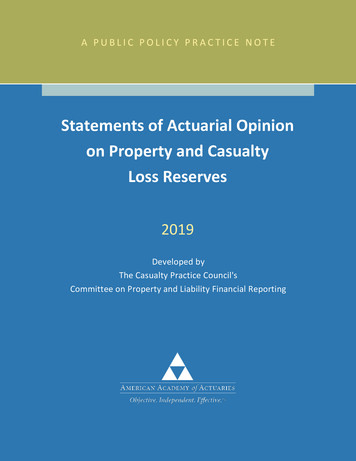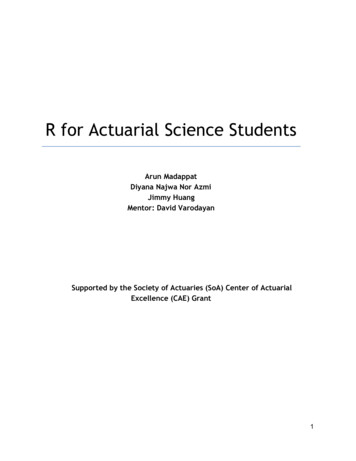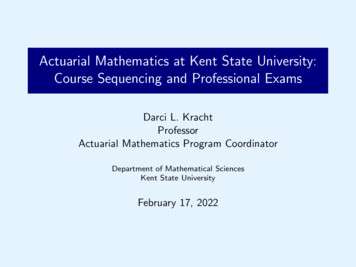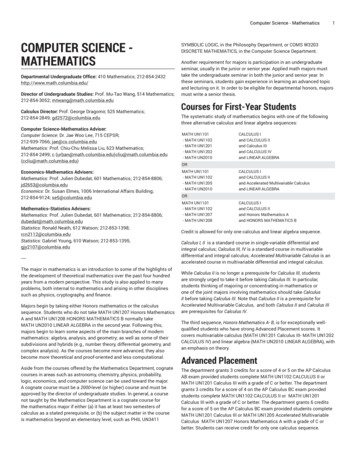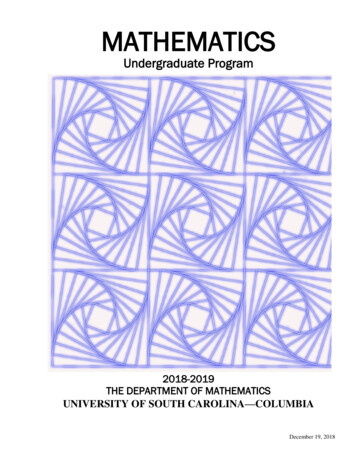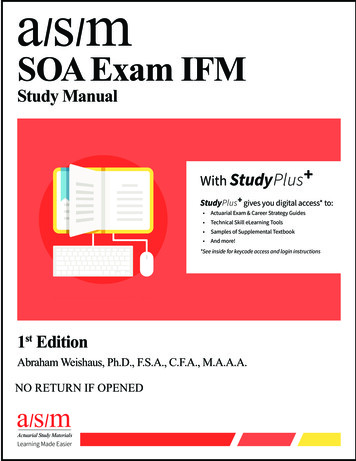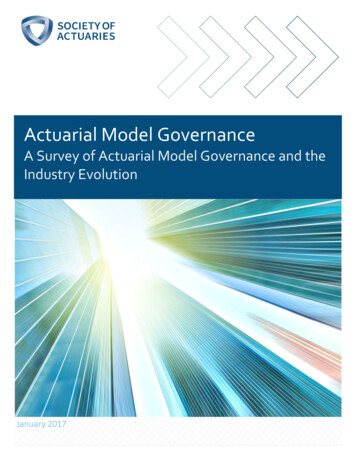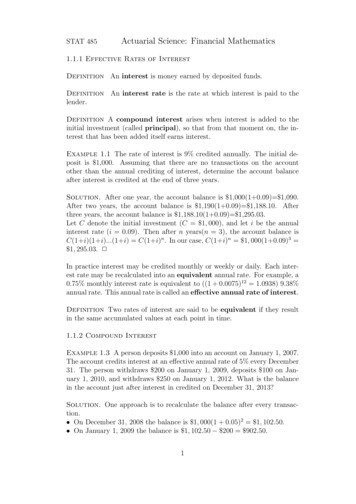
Transcription
STAT 485Actuarial Science: Financial Mathematics1.1.1 Effective Rates of InterestDefinition An interest is money earned by deposited funds.Definition An interest rate is the rate at which interest is paid to thelender.Definition A compound interest arises when interest is added to theinitial investment (called principal), so that from that moment on, the interest that has been added itself earns interest.Example 1.1 The rate of interest is 9% credited annually. The initial deposit is 1,000. Assuming that there are no transactions on the accountother than the annual crediting of interest, determine the account balanceafter interest is credited at the end of three years.Solution. After one year, the account balance is 1,000(1 0.09) 1,090.After two years, the account balance is 1,190(1 0.09) 1,188.10. Afterthree years, the account balance is 1,188.10(1 0.09) 1,295.03.Let C denote the initial investment (C 1, 000), and let i be the annualinterest rate (i 0.09). Then after n years(n 3), the account balance isC(1 i)(1 i).(1 i) C(1 i)n . In our case, C(1 i)n 1, 000(1 0.09)3 1, 295.03. 2In practice interest may be credited monthly or weekly or daily. Each interest rate may be recalculated into an equivalent annual rate. For example, a0.75% monthly interest rate is equivalent to ((1 0.0075)12 1.0938) 9.38%annual rate. This annual rate is called an effective annual rate of interest.Definition Two rates of interest are said to be equivalent if they resultin the same accumulated values at each point in time.1.1.2 Compound InterestExample 1.3 A person deposits 1,000 into an account on January 1, 2007.The account credits interest at an effective annual rate of 5% every December31. The person withdraws 200 on January 1, 2009, deposits 100 on January 1, 2010, and withdraws 250 on January 1, 2012. What is the balancein the account just after interest in credited on December 31, 2013?Solution. One approach is to recalculate the balance after every transaction. On December 31, 2008 the balance is 1, 000(1 0.05)2 1, 102.50. On January 1, 2009 the balance is 1, 102.50 200 902.50.1
OnOnOnOnOnDecember 31, 2009 the balance is 902.50(1 0.05) 947.63.January 1, 2010 the balance is 947.63 100 1, 047.63.December 31, 2011 the balance is 1, 047.63(1 0.05)2 1, 155.01.January 1, 2012 the balance is 1, 155.01 250 905.01.December 31, 2013 the balance is 905.01(1 0.05)2 997.77.An alternative approach is to accumulate each transaction to the December 31, 2013 date of valuation and then combine all accumulated values,adding deposits and subtracting withdrawals. We have ( 1, 000)(1 0.05)7 ( 100)(1 0.05)4 ( 200)(1 0.05)5 ( 250)(1 0.05)2 997.77 2.Definition The accumulation factor from time 0 to time t is the accumulated value at time t of an investment of 1 made at time 0. Theaccumulation factor will be denoted by a(t).Definition The accumulated amount function, denoted by A(t), is theaccumulated amount of an investment at time t, A(t) A(0)a(t).Example Under compound interest, the accumulation factor from 0 to t isa(t) (1 i)t where i is the effective annual rate of interest, and time t is apositive real number. 2Example Under compound interest, the accumulated amount by time tsatisfies the equation A(t) A(0)(1 i)t . Given any of the three quantities A(t), A(0), i, and t, it is possible to find the fourth.The formulasare()t tA(t) A(0)(1 i) , A(0) A(t)(1 i) , t ln A(t)/A(0) / ln(1 i),()1/tand i A(t)/A(0) 1. For instance, find the time it takes for an initialinvestment of 100 to grow to 150 under the compound annual rate of 5%.Solution: t ln(150/100)/ ln(1.05) 8.31. 2In practice, transactions can take place any time during a year. If time ismeasured in months, it is common to express t in the form t m/12 years.If time is measured in days, use t d/365 years.1.1.3 Simple InterestDefinition Simple interest is an interest that is paid only on the principal amount. The accumulation function from time 0 to time t at annualsimple interest rate i is a(t) 1 it where t is measured in years.Comparison of Compound and Simple Interests2
a(t)6(1 i)t1 i1 it-t01From the picture, the simple interest accumulation factor is larger than thatfor compound interest if 0 t 1, and is smaller for t 1.Interest accumulation is often based on a combination of simple and compound interests. Compound interest would be applied over the completednumber of years (that is, interest compounding periods), and simple interestwould be applied from then to the fractional point in the current interest period. For example, at annual rate 9% (i 0.09), over a period of 4 years and 5months, an investment of 1,000 will grow to 1, 000(1 i)(4 (1 it) where t ) 5months 5/12 years, that is, it will grow to 1, 000(1.09)4 1 (5/12)(0.09) 1, 464.52 with the accumulation factor of 1.46452.Definition A promissory note is a short-term contract requiring the issuer of the note (the borrower) to pay the holder of the note (the lender) aprincipal amount plus interest on that principal at a specified annual interestrate for a specified length of time. The length of time is usually less thanone year, and the interest is calculated on the basis of simple interest. Theinterest rate earned by the lender is sometimes referred to as the yield rateof the investment.Example 1.4 On January 31 Smith borrows 5,000 from Brown and givesBrown a promissory note. The note states that the loan will be repaid onApril 30 of the same year, with annual interest at 12%. On March 1 Brownsells the promissory note to Jones, who pays Brown amount of money X inreturn for the right to collect the payment from Smith on April 30. Jonespays Brown an amount such that Jones’ yield from March 1 to the maturitydate (April 30) can be stated as an annual rate of interest of 15%. Assumeall calculations are based on simple interest and a 365-day year.t1 29/365January 31t2 60/365April 30March 1Brown receivesSmith borrows 5,000 from Brown X from Jones3Jones receives 5,146.30 from Smith
(a) Determine the amount Smith was to have paid Brown on April 30.Solution The payment required at the maturity date is 5, 000(1 (0.12)(89/365)) 5, 146.30.(b) Determine X, the amount Jones paid to Brown.Solution The period from March 1 to April 30 is t2 60/365. X satisfiedthe equation 5, 146.30 X(1 (0.15)(60/365)). Thus, X 5,022.46.(c) Determine the yield rate Brown earned.Solution Let t1 29/365 denote the period from January 31 to March1, and let j1 be the annual yield rate earnedby Brown. Then[() ]j1 solves theequation X 5, 000(1 j1 t1 ) or j1 5, 022.46/ 5, 000 1 /(29/365) 0.0565 or 5.65%. 21.2 Present ValueDefinition Let X be the amount that must be invested at the start of atime period to accumulate 1 at the end of the period at effective annualinterest rate i. Then X satisfies the equation X(i i) 1, or equivalently,X 1/(1 i). The quantity v 1/(1 i) is called the present value ofan amount of 1 due in one time period (or present value factor ordiscount factor).Example 1.5 A person invests X in a risky fund, which average annualrate of return is 19.5%. What amount must the person invest in order toaccumulate 1,000,000 in 25 years?Solution The amount X solves the equation X(1 i)25 1, 000, 000.Thus, X 1, 000, 000 v 25 1, 000, 000(1.195) 25 11, 635.96. 21.3 Equation of ValueDefinition Any financial transaction can be represented in the form ofan equation. The components of the equation are the interest rate and theamounts of money disbursed and received. These amounts are termed datedcash flows (inflow and outflow). The equation is called an equation ofvalue for the transaction, because it balances the accumulated and presentvalues of the payments made at different time points.In order to formulate an equation of value for a transaction, it is necessaryto choose a reference time point called valuation date. At the referencetime point, the equation of value balances (1) the accumulated value of allpayments already disbursed plus the present value of all payments yet to be4
disbursed, and (2) the accumulated value of all payments already receivedplus the present value of all payments yet to be received.Example 1.7 On February 7,14,21 and 28, a person draws 1,000 creditthat charges an effective weekly interest rate of 8% on all credit extended.He pays his debt in four installments which he makes on March 7, 14,21, and28. He pays 1,100 on each March 7, 14, and 21. How much must he pay onMarch 28 to repay his debt completely?ReceivedPaidFeb 7 Feb 14 Feb 21 Feb 28Mar 7 Mar 14 Mar 21 Mar 28 1, 000 1, 000 1, 000 1, 000 1, 100 1, 100 1, 000XSolution 1 (straightforward) Walt’s debt on February7 is 1,000;(on February14, 1,000(1 i) 1,000;onFebruary21, 1,000(1 i) )()2 1, 000((1 i) 1, 000 ) 1, 000 (1 i) (1 i)( 1 ; on February 28,2 1, 000000 (1 i)3 (1 i)2 ) (1 ) (1 i) (1 i) 1 (1 i) 1, 000( 1,i) 1 . On March 7,(the debt is , 1000 (1 i)3 (1 )i)2 (1 i) 1 (1 i) ( 1, 100 , 1000 (1 i)4 (1 i)3 (1 i)2 (1 i) ) 1, 100; on March()43214, , 1000 (1 i) (1 i) (1 i) (1 i) 1, 100 (1 i) 1, 100 ()()5 , 1000 (1 i)4 (1 i)3 (1 i)2 1, 100 (1 i) 1 ; on( i) (1()(March 21, , 1000 (1 i)5 (1 i)4 (1 i)3 (1 i)2 1, 100 (1 ))()i) 1 (1 i) 1, 100 , 1000 (1 i)6 (1 i)5 (1 i)4 (1 i)3 (()( 1, 100 (1 i)2 (1 i) 1 ; on March 28; X , 1000 (1 i)6 (1 )())(5432i) (1 i) (1 i) 1, 100 (1 i) (1 i) 1 (1 i) , 1000 (1 )()i)7 (1 i)6 (1 i)5 (1 i)4 1, 100 (1 i)3 (1 i)2 (1 i) 2, 273.79.Solution 2 Choose March 28 as the reference time point for valuation.Then the accumulated value of all payments received on February 7, 14, 21,28 are 1, 000(1 i)7 , 1, 000(1 i)6 , 1, 000(1 i)5 , and 1, 000(1 i)4 ,respectively. The accumulated value of all payments paid on March 7, 14,21, and 28 are, respectively, 1, 100(1 i)3 , 1, 100(1 i)2 , 1, 100(1 i), andX. The equation of value is the difference between the accumulated valuesof all the sums received and all the sums paid, that is, the equation of valueis][][ 1, 000 (1 i)7 (1 i)6 (1 i)5 (1 i)4 1, 100 (1 i)3 (1 i)2 (1 i) X 0 .From here X 2, 273.79.5
Solution 3 Choose February 7 as the reference time point. Then thepresent value of the sums that will be received on February 7, 14, 21, 28are 1, 000, 1, 000/(1 i) 1, 000v, 1, 000/(1 i)2 1, 000v 2 , and 1, 000/(1 i)3 1, 000v 3 , respectively, where v is the present value factor. The present value of the sums that will be paid on March 7, 14, 21,and 28 are, respectively, 1, 100/(1 i)4 1, 100v 4 , 1, 100/(1 i)5 1, 100v 5 , 1, 100/(1 i)6 1, 100v 6 , and Xv 7 . The equation of value isthe difference between the present values of all the sums that will be receivedand all the sums that will be paid, that is, the equation of value is[][] 1, 000 1 v v 2 v 3 1, 100 v 4 v 5 v 6 Xv 7 0 .From here X 2, 273.79.Solution 4 Choose February 21 as the reference time point. Then the accumulated value of the payments received on February 7 and 14 are 1, 000(1 i)2 and 1, 000(1 i), respectively. The present value of the payments thatwill be received on February 21 and 28 are 1, 000 and 1, 000/(1 i), respectively. The present value of the amounts that will be paid on March 7, 14,21, and 28 are, respectively, 1, 100/(1 i)2 , 1, 100/(1 i)3 , 1, 100/(1 i)4 ,and X/(1 i)5 . The equation of value is[[ 11 ]11 ]X2 1, 000 (1 i) (1 i) 1 1, 100 0.234(1 i)(1 i) (1 i) (1 i)(1 i)5From here X 2, 273.79. 21.4 Nominal Rates of InterestDefinition A nominal annual interest rate i(m) compounded mtimes per year refers to an interest rate i(m) /m compounded every 1/mthof a year.Example 1.8 A credit card account charges 24% on unpaid balances, payablemonthly. The quoted rate of 24% is a nominal annual interest rate. A personputs 1,000 on his credit card, and doesn’t pay for one year.(a) How much does he owe according to his 13th statement?(b) Compute an effective annual interest rate.Solution (a) The monthly interest rate is i(12) 24/12 2%. His 1ststatement is for 1,000 and doesn’t charge interest. His 13th statement is for 1, 000(1.02)12 1, 268.23.(b) The effective annual rate of interest is 26.823%. 2Definition A nominal annual interest rate is sometimes called an annualpercentage rate (APR). The corresponding monthly interest rate is called6
a periodic rate.Example 1.9 Bank A offers an annual interest rate of 15.25% compoundedsemiannually, and Bank B offers an annual rate of 15% compounded monthly.Which bank offers a higher effective annual interest rate?(2)Solution The periodic rate in Bank A is iA 15.25%/2 7.625%. Thus,a deposit of 1 in Bank A will grow to (1 0.07625)2 1.158314. The pe(12)riodic rate in Bank B is iB 15%/12 1.25%. A deposit of 1 will growto (1.0125)12 1.160755. Hence, the effective annual interest rates in BankA and B are 15.8314% and 16.0755%, respectively. Bank B has a highereffective annual interest rate. 2The formula that connects the nominal annual interest rate i(m) and theeffective annual interest rate i is(i(m) )m1 1 i.mExample 1.10 Suppose an effective annual rate of interest is 12%. Findthe equivalent nominal annual rate for m 1, 12, 365, and .[]Solution Using the formula i(m) m (1 i)1/m 1 , we [compute i(1) ]i 0.12, i(12) 0.1139, i(365) 0.113346. When m , m (1 i)1/m 1 ln(1 i) 0.113329. The limiting case m is called continuouscompounding. 21.5 Effective and Nominal Rates of DiscountDefinition An interest payable at the end of an interest period is calledinterest payable in arrears.Definition An interest payable at the beginning of an interest period iscalled interest payable in advance.Definition The rate of interest payable in advance is called the rate ofdiscount.Example. A person borrows 1,000 for one year at an interest rate of 10%payable in advance. It means that he receives the loan amount of 1,000 butmust immediately pay the lender 100. Thus, the net loan amount is 900.One year later he must repay 1,000. The effective annual rate of interest ofthis transaction is 100/900 0.1111 or 11.11%. 2Definition The effective annual rate of discount from time 0 to time1 isA(1) A(0)d A(1)7
where A(t) is the accumulated amount function.Example In our example, A(1) 1, 000, A(0) 900, d (1000 900)/1000 100/1000 0.10 or 10%. 2Recall that the effective annual rate of interest satisfies the equality A(1) A(0)(1 i). Therefore,A(1) A(0)i .A(0)From here, the equalities holdd idand i .1 i1 dExample In our example, i 0.1/(1 0.1) 1/9 0.1111, and d (1/9)/(1 1/9) 1/10 0.10. 2Definition A nominal annual discount rate d(m) compounded mtimes per year refers to a discount rate d(m) /m compounded every 1/mthof a year.The relation between d and d(m) is(d(m) )m1 d 1 .mProof: By definition, A(0) A(1)(1 d). Hence,A(0) A(1/m)(1 d(m) /m) A(2/m)(1 d(m) /m)2 . A(1)(1 d(m) /m)m ,which proves the formula.Example 1.12 Suppose an effective annual rate of interest is 12%. Findthe equivalent nominal annual rate of discount for m 1, 12, 365, and .Solution First compute the effective annual rate of discount0.12i 0.107143 .1 i1.12][Using the formula d(m) m 1 (1 d)1/m , we compute[d(1) d 0.107143,]d(12) 0.1128, d(365) 0.1133. When m , m 1 (1 d)1/m ln(1 d) 0.113329 ln(1 i). 2d Show that is it always so: ln(1 d) ln(1 i).1.6 The Force of Interest8
The interest rate by the investment for the 1/mth of a year period from timet to time t 1/m isA(t 1/m) A(t).A(t)The nominal annual rate of interest compounded m times per year isi(m) mA(t 1/m) A(t).A(t)Letting m , we get the nominal annual interest rate compoundedcontinuously,i( ) lim mm A(t 1/m) A(t)A′ (t) .A(t)A(t)Example 1.13 From Example 1.10, i( ) ln(1 i). Indeed, A(t) A(0)(1 i)t , thus, A′ (t) A(0)(1 i)t ln(1 i) A(t) ln(1 i). Hence,i( ) A′ (t)/A(t) ln(1 i). 2Definition The force of interest at time t isδt A′ (t).A(t)To express the accumulated amount function A(t) in terms of the force ofinterest, solve the differential equationA′ (t)d ln[A(t)] .A(t)dt{ t}The solution is A(t) A(0) exp 0 δu du .δt Example 1.14 Given δt 0.08 0.005t, find an accumulated value overfive years of an investment of 1,000 made at time (a) t 0, (b) t 2.Solution} (a) A(0) 1, 000, and A(5) A(0) exp0.005u)du 1000 exp{0.4625} 1588.04.(b) A(2) 1000, and A(7) A(2) exp{ 50}{ 5δu du 1000 exp 0 (0.08 }(0.08 0.005u)du 1669.46. 22{ 7}{ tIf the force of interest is constant, δt δ, then A(t) A(0) exp 0 δu du exp{δ t}. On the other hand, we know that A(t) A(0)(1 i)t for a constanteffective annual interest rate i. Hence, δ ln(1 i) or i eδ 1.9
1.7 Inflation and the“Real” Rate of InterestDefinition Inflation is a rise in the general level of prices of goods andservices in an economy over a period of time.Definition A chief measure of price inflation is the inflation rate, thepercentage change in the Consumer Price Index (CPI) over time, generallyquoted on an annual basis. The change in the CPI measures the effectiveannual rate of change in the cost of a specified basket of consumer goodsand services.Definition (Explanation is in Example 1.16). With effective annual interest rate i and annual inflation rate r, the real rate of interest for the yearisireal value of real return in the end of the year dollarsi r .value of invested amount in theend of the year dollars1 rExample 1.16 A person invests 1,000 for one year at effective annual interest rate of 15.5%. At the time Smith makes the investment, the cost ofa certain consumer item is 1. One year later, the interest is paid and theprincipal returned. Assume that the inflation is 10%.(a) What is the annual growth rate in purchasing power (the number ofitems that can purchased) with respect to the consumer item?Solution (a) At the start of the year, Smith can buy 1,000 items. Atthe end of the year, he receives 1, 000(1.155) 1, 155. Due to inflation, the cost of the item at the end of the year is 1.10. Smith is ableto buy 1,155.00/ 1.10 1,050 items. Thus, his purchasing power has grownby (1050-1000)/1000x100% 5%.(b) Compute the real rate of interest.Solution ireal (0.155 0.1)/(1 0.1) 0.055/1.1 0.05 or 5%.Note that the real interest rate can be defined as the rate of change in purchasing power. Indeed, the general formula for the rate of change in purchasingpower isA(0)(1 i) A(0)i r1 iP (1 r)P 1 . 2 A(0)1 r1 rP2.1 Level Payment AnnuitiesDefinition An annuity is a series of periodic payments.10
Definition An annuity-certain is a series of payments that are definitelymade. They are not contingent upon occurrence of any random event.Definition An annuity-immediate is a series of payments made at theend of each period.Definition An annuity-due is a series of payments made at the beginningof each period.For now we will study annuity-immediate.Example 2.1 A person deposits 30 in a bank account on the last day ofeach month. The annual interest rate is 9% compounded monthly, and theinterest is paid into the account on the last day of each month. Find theaccount balance after the 140th deposit.Solution Let j i(12) 0.09/12 0.0075 or 0.75%. The account balance[after ]the 1st deposit is 30; 30 (1 [ after the] 2nd one, 30(1 [ j) 30]j) 1 ; after the 3rd, 30 (1 j) 1 (1 j) 30 30 (1 j)2 (1 j) 1 .After the 140th deposit, the balance is[ 30 (1 j)139138 (1 j)][ (1 j)140 1 ] 7, 385.91. 2 . (1 j) 1 30(1 j) 1Definition The accumulated value of an n-payment annuity-immediateof 1 per period is(1 i)n 1snqi iwhere i is the constant interest rate per payment period.Example In our example, s140q0.0075 7, 385.91/30 246.197. 2Example After the n payments are completed, the balance snqi , if not withdrawn, will continue to accumulate with interest only. After k time periods,the balance will besnqi (1 i)k (1 i)n 1(1 i)n k (1 i)k(1 i)k ii(1 i)n k 1 (1 i)k 1 sn kqi skqi .iiUseful formula:sn kqi snqi (1 i)k skqi .Note that n and k are switched in this formula in the textbook. 2Extensions of this formula prove to be useful.11
Example 2.4 (Annuity accumulation with non-level interest rate) Notethat “non-level” means “non-constant”. Suppose in Example 2.1, after 68months, the nominal interest rate changes to 7.5% still compounded monthly.Find the balance after 140 months.Solution After 68 months, the balance is 30 s68q0.0075 2, 648.50. Duringthe next 72 months, the balance accumulates to 2, 648.50(1 0.75/12)72 2, 648.50(1.00625)72 4, 147.86.The remaining deposits continuing for the last 72 monthsaccumulate to[ 30 s72q0.00625 2, 717.36. Thus, the total balance is 30 s68q0.0075 (1.00625)72 ]s72q0.00625 6, 865.22. 2Example 2.5 (Annuity accumulation with a changing payment) Supposethat 10 monthly payments of 50 each are followed by 14 monthly paymentsof 75 each. If the effective monthly rate is 1%, what is the accumulatedvalue the annuity at the time of the final payment?Solution At the time of the final payment, 24 months later, the accumulated value of the first 10 payments is 50 s10q0.01 (1.01)14 601.30. Thevalue of the final 14 payments, also valued at time 24 months is 75 s14q0.01 1, 121.06. Thus, the total balance is 1,722.36. 22.1.2 Present Value of an AnnuityExample 2.6 The 1st withdrawal from an account will take place one yearfrom now. There will be four yearly withdrawals of 1,000 each. The accounthas an effective annual interest rate of 6%. Calculate an amount of a singledeposit today so that the account balance will be reduced to 0 after the 4thwithdrawal.Solution Suppose that the amount of the initial deposit is X. The account balance after the 1st withdrawalis X(1.06) ] 1, 000. The bal[ance after the 2nd withdrawal is X(1.06) 1, 000 (1.06) 1, 000 X(1.06)2 1, 000(1.06)[ 1, 000. The balance after the ]3rd withdrawal is(note a typo in the text) X(1.06)2 1, 000(1.06) 1, 000 (1.06) 1, 000 X(1.06)3 1,[ 000(1.06)2 1, 000(1.06) 1, 000. The balance after] the 4thwithdrawal is X(1.06)3 1, 000(1.06)2 1, 000(1.06) 1, 000 (1.06) 1, 000 X(1.06)4 1, 000(1.06)3 1, 000(1.06)2 1, 000(1.06) 1, 000.Since the final balance is zero, X solves X(1.06)4 1, 000(1.06)3 1, 000(1.06)2 1, 000(1.06) 1, 000,or equivalently, X ][ 1, 000 1, 000 1, 000 1, 000 1, 000 v v 2 v 3 v 42341.06(1.06)(1.06)(1.06)12
[]1 v41 1 v4 1, 000 v 1 v v 2 v 3 1, 000 v 1, 00011 v1 i 1 1 i1 v41 (1.06) 4 1, 000 3, 465.11 . 2i0.06Definition The present value of an n-payment annuity-immediateof 1 per period is 1, 000anqi v v 2 · · · v n 1 vniwhere i is the constant interest rate per payment period.Example 2.7 (Loan repayment) A person takes a 12,000 loan and has tomake monthly payments for 3 years, starting one month from now, with anominal interest rate of 12% compounded monthly. Find a monthly paymenton this loan and the total amount of payment.Solution Let P be a monthly payment. It solves 12, 000 P a36q0.01 .Hence, 12, 000 12, 000 P 398.57a36q0.01(1 (1.01) 36 )/0.01and the total payment is 398.57(36) 14, 348.52. 2Definition A k-period deferred, n-payment annuity of 1 per period is a series of n payments that start k 1 time periods from now.Example 2.8 Suppose in the previous example, the 1st payment starts 9months from now. Find monthly and total payments.Solution A monthly payment P satisfies[] 12, 000 P v 9 v 10 · · · v 44 P v 8 a36q0.01 .Thus, P 12, 000 12, 000 (1.01)8 (1.01)8 ( 398.57) 431.60,8v a36q0.01a36q0.01and the total payment is 431.60(36) 15, 537.60. 2.[]From the relation v k v v 2 · · · v n v k anqi , we getkv anqiv k v n k1 v n k 1 v k1 vn an kqi akqi . viiiikA useful formula is an kqi v k anqi akqi .13
Example A person takes a 12,000 loan and has to make monthly paymentsfor the first year at the interest rate of 10% compounded monthly, and forthe following 2 years with the interest rate of 12% compounded monthly.The first payment is due one month from now. Find a monthly payment onthis loan and the total amount of payment.Solution Let P be a monthly payment. The effective monthly interestrate for the 1st year is i1 0.10/12 0.0083, while for the next two years,it is i2 0.12/12 0.01. The amount of monthly payment P solves theequation[] 12, 000 P a12qi1 (1 i1 ) 12 a24qi2[ 1 (1 i ) 121 (1 i2 ) 24 ]1 P (1 i1 ) 12 (30.6043) P,i1i2Thus, P 392.10 and the total amount paid is ( 392.10)(36) 14, 115.60. 22.1.2.3. Relationship Between anqi and snqi .Recall that snqi is the accumulated value of an annuity-immediate at thetime of the last nth payment. The quantity anqi is the present value of ann-payment annuity-immediate one period before the 1st payment. Thus, thevaluation point of the present value is n periods earlier than that for theaccumulated value. Therefore,snqi (1 i)n anqi ,or equivalently,anqi v n snqi .This equality can be verified algebraically by observing thatv n snqi 1 [ (1 i)n 1 ] 1 v n anqi .(1 i)nii2.1.2.4 Valuation of PerpetuitiesNote that11 vn .lim anqi limn n iiThis expression can also be derived by summing the infinite series of presentvalues of paymentsv v 2 v 3 · · · v(1 v v 2 · · · ) v1111 .1 1 v1 i 1 1 iiDefinition An annuity that has no definite end is called a perpetuity.Notation The present value of a perpetuity is denoted by a qi 1/i.14
Example 2.10 A person deposits 10,000 in a bank account that offers aneffective annual interest rate of 8% (e.g., buys a certified deposit). In oneyear, he withdraws 800 of interest. The principal amount of 10,000 remains in the account and generates 800 the following year. If the personkeeps withdrawing only the interest, the process will go forever. This is whatis called ”lives off the interest”. 2There is another way to derive the expression for a qi . Let X denote theamount that has to be invested to generate 1 interest per time period. Then X solves Xi 1, or X 1/i.2.1.3 Annuity-Immediate and Annuity-DueRecall in case of an annuity-immediate payments are made at the end ofvaluation periods, while an annuity-due payment is made at the beginningof each period.Definition The present value of an n-payment annuity-due at the time ofthe 1st payment isänqi 1 v v · · · v2n 11 vn1 vn 1 vdwhere d i/(1 i) 1 1/(1 i) 1 v is the rate of discount. Theaccumulated value one period after the final payment is[ (1 i)n 1(1 i)n 1s̈nqi (1 i) (1 i)2 · · · (1 i)n (1 i) .idNote the relationshipsänqi (1 i) anqi and s̈nqi (1 i) snqi .Example 2.11 A person makes monthly deposits of 200 into a fund earning 6% annual interest compounded monthly. The first deposit occurred onJanuary 1, 1995. Compute the accumulated balance on December 31, 2009.Solution There are 180 deposits. The monthly interest rate is 0.06/12 0.005or 0.5%. The accumulated value is 200 s̈180q0.005 200(1.005)(1.005)180 1 58, 454.56. 20.0053.1 Amortization Method of Loan PaymentDefinition A loan repayment involves paying down the principal amountof the loan as well as the accumulating interest on the loan.15
Definition An amortizing loan is a loan where the principal is paid downover the life of the loan, according to some amortization schedule.The origin of the word “ amortize” is Latin mort death.Example Consider a loan of amount 1,000 with an interest rate of 10%per year. Suppose there is a payment of 200 at the end of the 1st year,a payment of 500 at the end of the 2nd year, and a final payment of Xat the end of the 3rd year. At the end of the 1st year, the amount owed,including interest, is 1000(1.1) 1,100. After a payment of 200, the outstanding balance is 900. At the end of the 2nd year, the amount owed is 900(1.1) 990. The payment of 500 reduces it to 490. At the end of the3rd year, the amount owed is 490(1.1) 539. Thus, the amount needed torepay the loan completely is 539. 2The amortization method requires that whenever a payment is made, interest is paid first, and any amount remaining is applied toward reducing theprincipal (goes towards principal). In particular, a periodic loan paymentcannot be less than accumulated interest for the time period.Example Consider our example from the point of view of interest and principal. The amortization of the loan can be summarized in an amortizationschedule.Time(in years)0123PaymentAmount– 200 500 539InterestDue– 1,000(0.1) 100 900(0.1) 90 490(0.1) 49PrincipalRepaid– 200- 100 100 500 90 410 539- 49 490OutstandingBalance 1,000 1000- 100 900 900- 410 490 490- 490 0Note that the outstanding balance can be updated from one year to the nextaccording to the equalities: 1, 000(1.1) 200 900, 900(1.1) 500 490, 490(1.1) 539 0.Now multiply the first equality by (1.1)2 and the second one by (1.1) andmoving all terms to the left-hand side, we get 1, 000(1.1)3 200(1.1)2 900(1.1)2 0, 900(1.1)2 500(1.1) 490(1.1) 0, 490(1.1) 539 0 .Now adding the equalities, we obtain 1, 000(1.1)3 200(1.1)2 500(1.1) 539 0,or equivalently, 1, 000 200v 500v 2 539v 3 . Hence, the original loanamount is equal to the present value of the loan payments (v is thepresent value factor or discount factor).16
Note also that the total amount paid is 200 500 539 1239, whichbreaks into the original loan amount of 1,000 and the interest of 239. Indeed, as seen from the table, the inte
1.1.1 Effective Rates of Interest Definition An interest is money earned by deposited funds. Definition An interest rate is the rate at which interest is paid to the lender. Definition A compound interest arises when interest is added to the initial investment (called principal), so that from that moment on, the in-
